Taxonomic classification
Kingdom: Animalia
Phylum: Chordata
Subphylum: Vertebrata
Class: Aves
Order: Galliformes
Family: Phasianidae
Subfamily: Phasianinae
Genus: Perdix
Species: Perdix perdix
Habitat
It spreads from the temperate zone of Europe, from Ireland to the Yenisey. Partridges are indigenous in natural steppes. It was successfully introduced to New Zealand, Canada and the United States as well. It feels well on fields, on cultivated but diverse regions, however, likes to have bushes as a nest nearby. It insists on its habitat and strays away only in hard winters, but this scattering usually threatens with die.
Morphology
The partridge is stocky, 29−32 cm long, has a wingspan of 45−48 cm and weights 350−450 grams. Its beak is covered by wax film. Plumage is different by sex, age and even region.
Nutrition
The partridge consumes only arthropods until 20 days old age. Later its nourishment is mainly seed of weeds, parts of green plants and insects that’s an important source of proteins. The diversity of food has great importance.
Habits
People on fields can be easily frightened when partridges fly up with wide wing-beats. Their scared voice can be heard at that time. It usually flies close to the ground because of its poor abilities and stays there where it’s landed. It’s shy and swift. Captive bred birds are easily domesticable.
Reproduction
Strictly monogamous, couples often spend the rest of their lives together. Hens scrape a hole in the soil at the end of April and lay their pear-shaped, smooth and slightly bright eggs. While hens are brooding, cocks are keeping guard. The brooding time is 24−25 days. The nestlings leave the nest right after birth. A family consists of 20−25 members, the leader is the male.
Its role in the ecosystem
As adult individuals mainly eat seeds of weeds, degree of reproduction of weeds is decreased. Furthermore it rolls back the reproduction of harmful insects.
Its role in the soil
Partridges look for feed by scratching the soil, thereby constantly rotate it. Soil plays an important role in its reproduction, as female lays its eggs into a hole scratched in the soil.
Endangerment
In winter it usually suffers from the lack of feed. People and raptorial birds hunt for it; its survival is due to its swift movement. In Hungary it’s not endangered and not protected. It’s allowed to be hunted from 1st October to 31th December.
Usability by people
Due to its delicious meat its hunted and bred.
http://hu.wikipedia.org/wiki/Fogoly
http://webcache.googleusercontent.com/search?q=cache:mZ3Jhs_gHvsJ:www.agr.unideb.hu/ktvbsc/dl2.php%3Fdl%3D37/6_eloadas.ppt+fogoly+t%C3%A1pl%C3%A1lkoz%C3%A1sa&cd=2&hl=hu&ct=clnk&gl=hu&client=firefox-a&source=www.google.hu
http://www.tananyag.almasi.hu/krez/a_mezo/madar/fogoly.htm
http://www.kislexikon.hu/fogoly_a.html
http://www.madarhatarozo.hu/facanfelek/fogoly-perdix-perdix.html
Csodálatos állatvilág, Mester Kiadó Kft., 2000
A tudás fája, Marshall Cavendish Kiadó, 1998-2003
